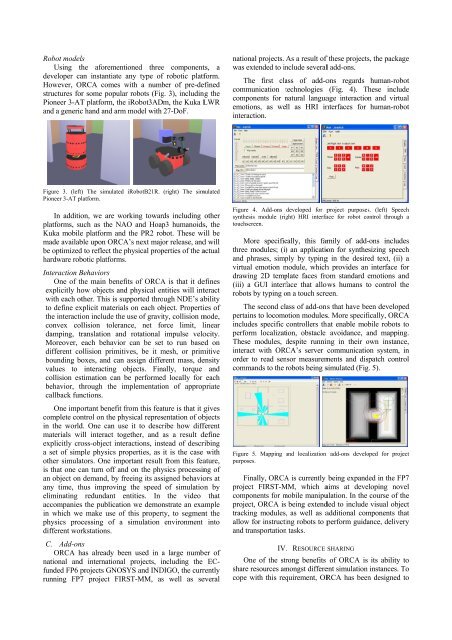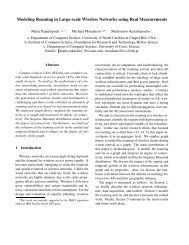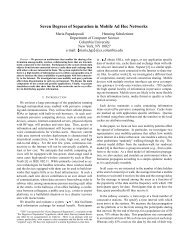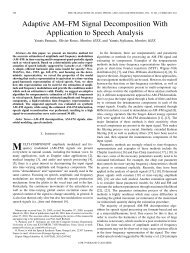ORCA: A physics based, robotics simulator able to distribute ...
ORCA: A physics based, robotics simulator able to distribute ...
ORCA: A physics based, robotics simulator able to distribute ...
You also want an ePaper? Increase the reach of your titles
YUMPU automatically turns print PDFs into web optimized ePapers that Google loves.
Robot models<br />
Using the aforementioned threee components, a<br />
developer can instantiate any type of f robotic platform.<br />
However, <strong>ORCA</strong> comes with a number of pre-defined<br />
structures for<br />
some popular robots (Fig. 3), includingng the<br />
Pioneer 3-AT<br />
platform, the iRobot3ADm, the Kuka LWR<br />
and a generic<br />
hand and arm<br />
model with 27-DoF.<br />
national projects. As a result of f these projects, the package<br />
was extended <strong>to</strong> include severall add-ons.<br />
The first class of add-ons regards human-robot<br />
communication technologies t<br />
(Fig. 4). These include<br />
components for natural n language interaction and virtual<br />
emotions, as well as HRI interfaces for human-robot<br />
interaction.<br />
Figure 3. (left)<br />
The simulated<br />
iRobotB21R. (right) The simulated<br />
Pioneer 3-AT platform.<br />
In addition, we are working <strong>to</strong>wards including other<br />
platforms, such as the NAO and Hoap3 humanoids, the<br />
Kuka mobile<br />
platform and<br />
the PR2 robot. These will be<br />
made avail<strong>able</strong> upon <strong>ORCA</strong>’s next major release, andd will<br />
be optimized<br />
<strong>to</strong> reflect the physical properties of the actual<br />
hardware robotic platforms.<br />
Interaction Behaviors<br />
One of the main benefits of <strong>ORCA</strong><br />
is that it defines<br />
explicitly how objects and physical entities will interact<br />
with each other. This is supported through NDE’s ability<br />
<strong>to</strong> define explicit materials on each object. Properties of<br />
the interaction include the<br />
use of gravity, collision mode,<br />
convex collision <strong>to</strong>lerance, net force limit, linear<br />
damping, translation and rotational impulse velocity.<br />
Moreover, each behavior can be set <strong>to</strong> run <strong>based</strong> on<br />
different collision primitives, be it mesh, or primitive<br />
bounding boxes, and can<br />
assign different mass, density<br />
values <strong>to</strong> interacting objects. Finally, <strong>to</strong>rque and<br />
collision estimation can be performed<br />
locally for each<br />
behavior, through the implementation of appropriate<br />
callback functions.<br />
One important benefit from this feature is that it gives<br />
complete control on the physical representation of objects<br />
in the world. One can use it <strong>to</strong> describe how different<br />
materials will interact <strong>to</strong>gether, and as a a result define<br />
explicitly cross-object interactions, instead of describing<br />
a set of simple <strong>physics</strong> properties, as it i is the case with<br />
other <strong>simula<strong>to</strong>r</strong>s. One important result from this feature,<br />
is that one can turn off and on the <strong>physics</strong> processing of<br />
an object on demand, by freeing its assigned behaviors at<br />
any time, thus improving the speed of simulationn by<br />
eliminating redundant entities. In the video that<br />
accompanies<br />
the publication we demonstrate an example<br />
in which we<br />
make use of this property, <strong>to</strong> segment the<br />
<strong>physics</strong> processing of a simulation environment in<strong>to</strong><br />
different workstations.<br />
C. Add-ons<br />
<strong>ORCA</strong> has already been used in a large number of<br />
national and<br />
international projects, ncluding the EC-<br />
running FP7<br />
project FIRST-MM, ass well as several<br />
funded FP6 projects GNOSYS and INDIGO, the currently<br />
Figure 4. Add-ons developed for project purposes. (left) Speech<br />
synthesis module (right) HRI interface for robot control through a<br />
<strong>to</strong>uchscreen.<br />
More specifically, this family of add-ons for synthesizing speech<br />
and phrases, simply by typingg in the desired text, (ii) a<br />
includes<br />
threee modules; (i)) an application<br />
virtual emotion module, m whichh provides an<br />
interface for<br />
drawing 2D template faces from standard emotions and<br />
(iii) a GUI interface that allows humans <strong>to</strong> t control the<br />
robots by typing on o a <strong>to</strong>uch screen.<br />
The second class of add-ons that have been developedd<br />
pertains <strong>to</strong> locomotion modules. More specifically, <strong>ORCA</strong><br />
includes specific controllers that en<strong>able</strong> mobile robots <strong>to</strong><br />
perform localization, obstacle avoidance, and a mapping.<br />
These modules, despite running in their own instance,<br />
interact with <strong>ORCA</strong>’s server communication system, in<br />
order <strong>to</strong> read sensor measurements and dispatch control<br />
commands <strong>to</strong> the robots being simulated (Fig. 5).<br />
Figure 5. Mapping and localization add-ons developed for project<br />
purposes.<br />
Finally, <strong>ORCA</strong>A is currently being expanded in the FP7<br />
project FIRST-MM, which aims at developing novel<br />
components for mobile m manipulation. In the course of the<br />
project, <strong>ORCA</strong> is being extended <strong>to</strong> includee visual object<br />
tracking modules, as well as additional components thatt<br />
allow<br />
for instructing robots <strong>to</strong> perform guidance, delivery<br />
and transportationn tasks.<br />
IV<br />
. RESOURCE SHARING<br />
One of the strong benefits of <strong>ORCA</strong> iss its ability <strong>to</strong><br />
share resources amongst different simulation<br />
instances. To<br />
cope<br />
with this requirement, <strong>ORCA</strong> has been<br />
designed <strong>to</strong>
















